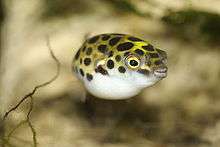Tetraodon nigroviridis
| Tetraodon nigroviridis | |
|---|---|
 | |
| Scientific classification | |
| Kingdom: | Animalia |
| Phylum: | Chordata |
| Class: | Actinopterygii |
| Order: | Tetraodontiformes |
| Family: | Tetraodontidae |
| Genus: | Tetraodon |
| Species: | T. nigroviridis |
| Binomial name | |
| Tetraodon nigroviridis Marion de Procé, 1822 | |
Tetraodon nigroviridis is one of the pufferfish known as the green spotted puffer. It is found across South and Southeast Asia in coastal freshwater and brackish water habitats.[1] T. nigroviridis reaches a typical maximum length of about 15 cm (5.9 in), with reports of up to 17 cm.[2] In February 2009, it was successfully bred in captivity at University of Florida using a new variation of the ovarian lavage technique.[3][4]
In the aquarium
This pufferfish, known as Midori fugu in Japanese, is a popular aquarium pet. Typically younger fish are sold with a length of 2–3 cm. These fish can be kept with others of the same type, or other fish, but they are a rather aggressive species, so they will often nip the fins or scales of other slow-moving fish. Although they may reach 15 cm in nature, they rarely exceed 10 cm in captivity. These fish are omnivores, and tend to feed mainly on small invertebrates and plant matter (such as seaweed) in nature. In captivity, they can be fed live bait or frozen bloodworms, but they can eat manufactured fish food if they are raised on it from a young age. One issue in feeding them manufactured food is that their teeth continuously grow, and in nature eating hard invertebrates helps grind their teeth down. Without hard food, their teeth continue to grow until it causes health problems. These problems can be solved by using fine coral sand in the tank, which the fish chew. Also, occasional feeding of snails or ghost shrimp can wear down their teeth naturally.
In nature, this species often travels to the limits of where salt water becomes fresh water, so they can be kept in fresh water for brief times. For long-term care, however, they should be kept in salt water. A salt concentration equal to 1/4th of ocean levels is suitable for younger fish, but adult fish spend most of their time in the ocean, so it is recommended to raise the salt level to 1/2 of ocean levels. Some also recommend using normal ocean water levels for adult fish. Suitable temperatures are 24-28 °C. A pH level of 8 is recommended.
Ecology
Adults of T. nigroviridis are found in freshwater streams, rivers, and flood plains; young are found in brackish water.[5] They are also found in mangrove forests.[1] Their diet consists primarily of snails, but includes mollusks, crustaceans, and some plant material.[5] This species may also be lepidophagous.[5]
Genetics
T. nigroviridis has the smallest known vertebrate genome, roughly 340 million base pairs,[6] and has thus been selected as a model organism for genetics. In 2004, a draft of its genome sequence was published.[6]
Colour
T. nigroviridis is green on the body with black spots. Its belly is white and its fins and tail are light green.
Commercial importance
T. nigroviridis is by no means a food fish, but has some value as bait and is very widely traded as an aquarium fish,[5] and is sometimes mistaken as the Ceylon puffer, Tetraodon fluviatilis. T. nigroviridis also has some value as a lab animal, in particular in genetics, because it has the same number of genes as human beings, but in a genome about one-tenth the size.[7]
References
- 1 2 Ebert, Klaus (2001-05-31). Aqualog: The Puffers of Fresh and Brackish Waters. Hollywood Import & Export, Inc. ISBN 3-931702-60-X.
- ↑ Schäfer F: Brackish Water Fishes, Aqualog 2005, ISBN 3-936027-82-X
- ↑ "University of Florida breeds spotted green puffer fish". AquaDaily. 2009-02-20. Retrieved 2009-02-20.
- ↑ http://news.ufl.edu/2009/02/17/puffer-fish/
- 1 2 3 4 Froese, Rainer and Pauly, Daniel, eds. (2007). "Tetraodon nigroviridis" in FishBase. August 2007 version.
- 1 2 Jaillon O, Aury J, Brunet F, Petit J, Stange-Thomann N, Mauceli E, Bouneau L, Fischer C, Ozouf-Costaz C, Bernot A, Nicaud S, Jaffe D, Fisher S, Lutfalla G, Dossat C, Segurens B, Dasilva C, Salanoubat M, Levy M, Boudet N, Castellano S, Anthouard V, Jubin C, Castelli V, Katinka M, Vacherie B, Biémont C, Skalli Z, Cattolico L, Poulain J, De Berardinis V, Cruaud C, Duprat S, Brottier P, Coutanceau J, Gouzy J, Parra G, Lardier G, Chapple C, McKernan K, McEwan P, Bosak S, Kellis M, Volff J, Guigó R, Zody M, Mesirov J, Lindblad-Toh K, Birren B, Nusbaum C, Kahn D, Robinson-Rechavi M, Laudet V, Schachter V, Quétier F, Saurin W, Scarpelli C, Wincker P, Lander E, Weissenbach J, Roest Crollius H (2004). "Genome duplication in the teleost fish Tetraodon nigroviridis reveals the early vertebrate proto-karyotype". Nature. 431 (7011): 946–57. doi:10.1038/nature03025. PMID 15496914.
- ↑ "Pufferfish and ancestral genomes". Retrieved 2013-01-18.
External links
| Wikimedia Commons has media related to Tetraodon nigroviridis. |
- Genome database.
- View the tetraodon genome in Ensembl